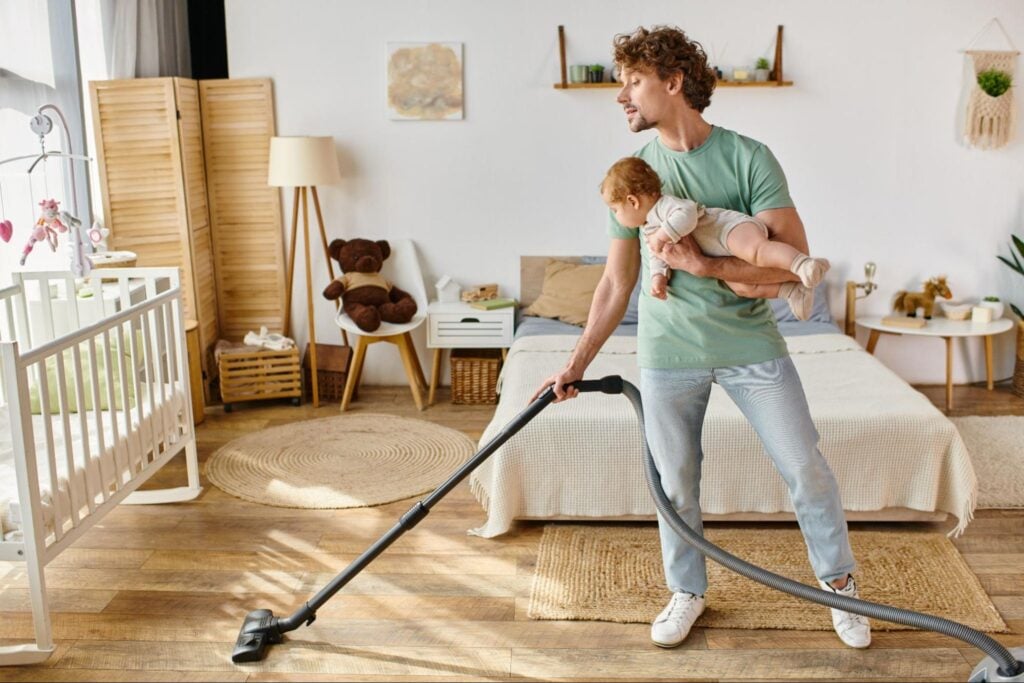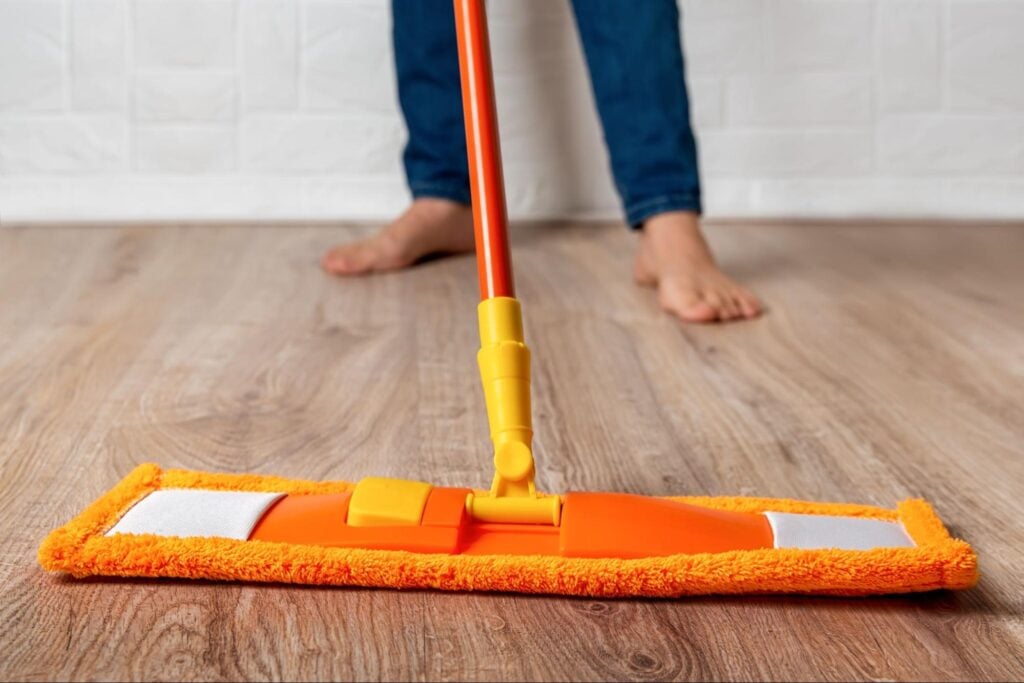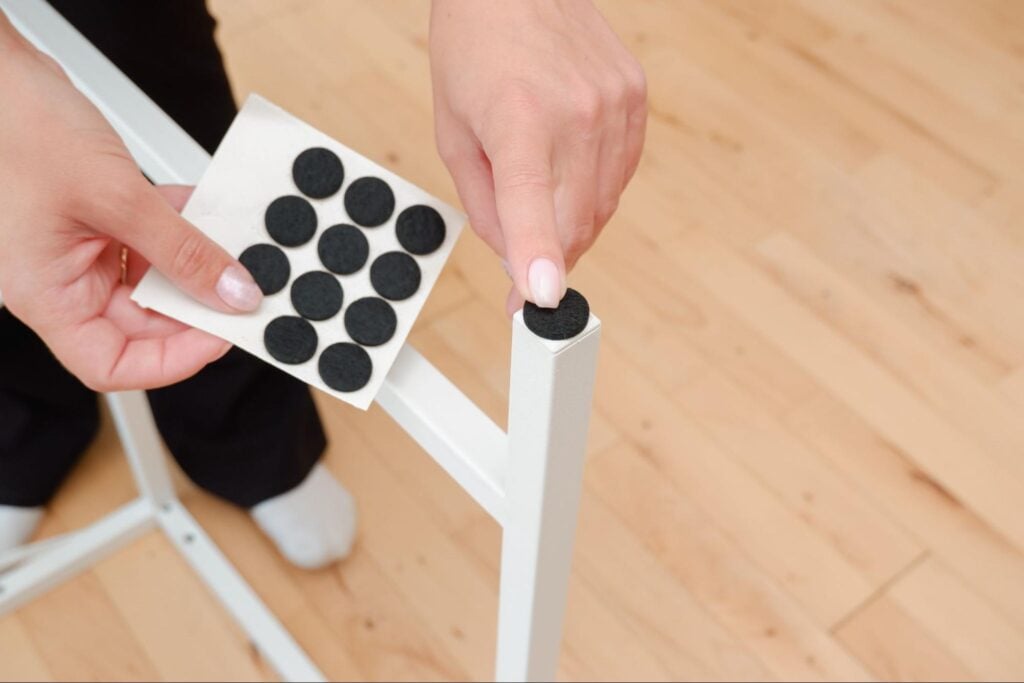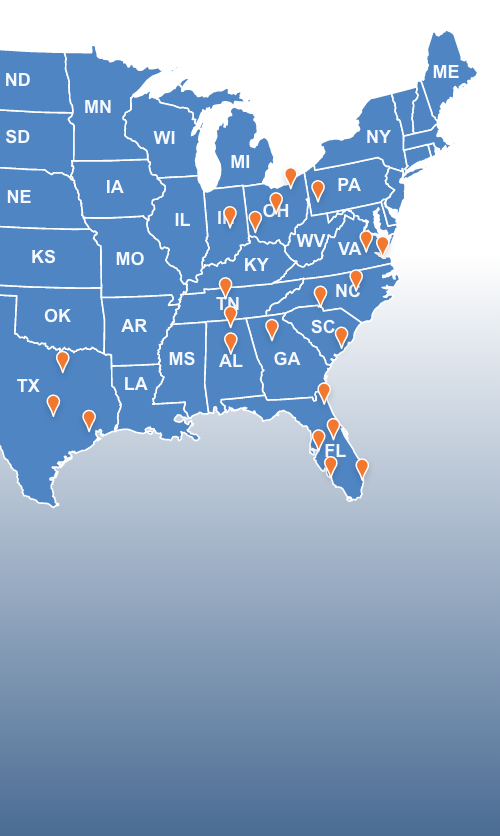

Caring for hardwood flooring can help it maintain its natural beauty for years to come. Hardwood floors bring warmth and elegance to any room, but they do need a bit of regular upkeep to stay looking their best.
Knowing how to clean hardwood floors properly can make a big difference in keeping your floors vibrant and durable. Simple habits like sweeping regularly, using gentle cleaners, and protecting the surface from scratches can make a big difference in keeping your floors vibrant and durable.
Whether you’re dealing with spills, scuffs, or everyday dirt, knowing how to care for your hardwood floors will help them stand the test of time. By following a few straightforward steps, you can enjoy the beauty of your hardwood flooring without constant worry.
For expert advice or professional assistance with your floors, contact 50Floor for trusted guidance and services.
Understanding Hardwood Floors
Hardwood floors are a popular choice for many homeowners due to their durability, aesthetic appeal, and ease of maintenance. However, to keep them looking their best, it’s essential to understand the basics of hardwood floors.
These floors are crafted from natural wood and can be finished in different ways, including polyurethane, oil, or wax. Each type of finish has its own set of characteristics and maintenance requirements. For instance, polyurethane finishes are known for their durability and ease of cleaning, while oil finishes may require more frequent reapplication to maintain their luster.
Understanding the type of finish on your hardwood floors is crucial for establishing an effective cleaning and maintenance routine. Additionally, hardwood floors can be prone to scratches, dents, and fading, especially if not properly maintained. Regular care and the right cleaning techniques can help mitigate these issues, ensuring your floors remain beautiful and resilient for years to come.
Importance of Hardwood Floor Care
Regular Maintenance
Regular maintenance is important to preserving the beauty and longevity of hardwood floors. A consistent hardwood floor cleaning routine prevents dirt and grime from building up.
It’s crucial to use the right hardwood floor cleaner. Harsh chemicals can damage the wood’s surface. Instead, opt for products specifically designed for hardwood flooring. This simple step keeps your floors looking beautiful for years.
Moisture Control
Moisture is a major enemy of hardwood floors. It can cause warping, swelling, and other damage. To protect your floors, wipe up spills immediately.
Also, maintain a stable indoor humidity level. This helps prevent moisture-related issues, ensuring your hardwood floor’s health remains intact.
UV Protection
Sunlight can fade and discolor hardwood over time. Use curtains or blinds to shield your floors from direct UV rays.
This not only maintains the color but also protects against premature aging. Your floors will retain their vibrant look longer.
Furniture and Foot Traffic
Heavy furniture and high foot traffic can scratch and wear down hardwood floors. Place protective pads under furniture legs and a mat or rug under office chairs. Encourage removing shoes at the door.
These steps minimize physical wear, keeping your floors in top condition.
Cleaning Hardwood Floors
Cleaning hardwood floors requires a gentle approach to avoid damaging the finish or the wood itself.


Here are some essential tips for cleaning hardwood floors:
- Sweep or Vacuum Regularly: Dirt, dust, and pet hair can accumulate quickly and act as abrasives that scratch the surface. Use a soft-bristle broom or a vacuum cleaner with a hardwood floor attachment to remove debris.
- Use a Microfiber Mop: A microfiber mop is ideal for cleaning hardwood floors, as it effectively picks up dust and dirt without scratching the surface. Pair it with a cleaning solution specifically designed for hardwood floors to ensure a thorough clean.
- Avoid Abrasive Cleaners: Harsh chemicals like bleach or ammonia can damage the finish and strip the wood of its natural oils. Stick to pH-neutral, non-abrasive cleaners that are safe for hardwood floors.
- Damp Mop with Care: While it’s important to clean your floors, too much water can cause warping and damage. Use a damp mop, not a wet one, and ensure you wring out excess water before mopping. Always dry the floor thoroughly after cleaning to prevent water spots.
- Regular Maintenance: Establish a regular cleaning routine to keep your floors looking their best. This includes weekly sweeping or vacuuming and mopping as needed to maintain their shine and cleanliness.
By following these tips, you can keep your hardwood floors clean and in excellent condition without risking damage.
Seasonal Maintenance Tips for Cleaning Hardwood Floors
Humidity Control
To keep hardwood floors in top condition, adjusting indoor humidity levels is important. During winter, when heating systems can dry out the air, use a humidifier to add moisture. This prevents the wood from contracting and developing gaps. In summer, a dehumidifier helps by removing excess moisture that could cause the wood to expand.
Humidifiers and dehumidifiers maintain optimal conditions. They protect your floor year-round from the effects of seasonal changes.
Cleaning Routines
Spring brings more dirt and pollen indoors, requiring frequent sweeping. A weekly cleaning schedule can keep these particles at bay.
In winter, salt and snow tracked inside demand immediate attention. Use a soft cloth or mop to clean up any wet spots or residue quickly.
Implementing seasonal cleaning routines addresses these specific challenges and ensures your hardwood flooring remains beautiful.
Preventing Scratches and Damage on Hardwood Floors


Furniture Pads
Install protective pads under furniture legs. They minimize surface scratches and dents. This simple step can preserve your hardwood’s beauty for years.
Furniture moves, even slightly, during daily use. Without pads, this movement can leave unsightly marks on your floors.
No-Shoes Policy
Encourage a no-shoes policy indoors. Shoes carry grit and dirt that scratch hardwood floors. Implementing this rule significantly reduces the amount of debris that can cause damage.
Area Rugs
Utilize area rugs and runners in high traffic zones. They shield wood from wear and tear. Rugs not only add aesthetic value but also serve as a barrier against scratches. Place them strategically to maximize protection.
Removing Stains and Spills
Removing stains and spills from hardwood floors can be a challenge, but it’s essential to act quickly to prevent them from setting into the wood.
Here are some tips for effectively handling stains and spills:
- Blot Immediately: As soon as a spill occurs, blot it with a clean cloth or paper towel. Avoid rubbing the stain, as this can damage the finish and push the liquid deeper into the wood.
- Use the Right Cleaning Solution: For most spills, a cleaning solution specifically designed for hardwood floors will do the trick. Apply it to the affected area and gently clean with a soft cloth.
- Tougher Stains: For more stubborn stains, a wood floor cleaner or a solution of equal parts white vinegar and warm water can be effective. Apply a few drops to the stain and gently scrub with a soft cloth.
- Dry Thoroughly: After cleaning, ensure the area is dried thoroughly to prevent water spots and potential damage. Use a dry cloth to absorb any remaining moisture.
By addressing spills and stains promptly and using the right cleaning techniques, you can prevent long-term damage and keep your hardwood floors looking pristine.
Refinishing Hardwood Floors for Longevity
Schedule Refinishing
Refinishing hardwood floors is important for their longevity. It not only restores the floor’s finish but also protects the wood beneath. Homeowners should plan to refinish their floors every 7-10 years, depending on foot traffic and wear. This schedule ensures the floor maintains its elegance and strength over time.
Professionals use specialized sanding equipment to remove the old finish. Then, they apply a fresh coat of oil or varnish. This process brings back the wood’s natural beauty and provides a layer of protection against daily wear.
Assess Regularly
Regular assessments help determine when refinishing is necessary. Look for signs of dullness, scratches, or fading. These indicate it’s time to consider refinishing. Early detection allows for timely maintenance, preventing more severe damage that can shorten the floor’s lifetime.
Homeowners should inspect their floors at least once a year. This proactive approach keeps floors in top condition, extending their durability and visual appeal.
Hire Professionals
For best results, hire professional services for refinishing. They have the expertise and equipment to ensure a high-quality finish. DIY projects might save money short-term but can lead to costly mistakes.
Professionals understand how to handle different wood types and finishes. They ensure a uniform look and durable surface. Investing in professional refinishing pays off by preserving the floor’s beauty and value over decades.
Final Thoughts
Caring for your hardwood floors goes beyond keeping them beautiful; it’s about protecting an important investment in your home. From regular maintenance to preventing scratches and using the right cleaning techniques, every small step helps your floors stay vibrant and strong over the years.
Refinishing when needed can also bring new life to your floors, making them look as fresh as the day they were installed. With the right care, your hardwood floors can offer elegance and warmth for decades to come.
For personalized advice or expert assistance, consider reaching out to 50Floor. Our team can provide you with the knowledge and support to keep your floors in top condition.
Don’t leave the beauty of your floors to chance—partner with 50Floor to help them stay stunning for years ahead!
Frequently Asked Questions
- How often should I clean my hardwood floors to keep them in top condition?
Regular cleaning, at least once a week, is essential to remove dirt and grime that can dull the floor’s finish.
- What is the best way to prevent scratches on hardwood floors?
Use protective pads under furniture legs, remove shoes before walking on the floor, and keep pets’ nails trimmed.
- Can seasonal changes affect my hardwood flooring?
Yes, wood expands and contracts with changes in humidity. Use a humidifier or dehumidifier as needed to maintain stable indoor humidity levels.
- What cleaning products are safe for hardwood floors?
Opt for pH-neutral, non-abrasive cleaners specifically designed for hardwood floors to avoid damaging the finish.
- How do I deal with spills on my hardwood floor?
Clean spills immediately with a dry or slightly damp cloth to prevent water damage and staining.
- When is it time to refinish my hardwood floors?
When your floor’s finish looks dull or worn despite regular cleaning, it might be time to refinish. Typically, every 7-10 years, depending on traffic and wear.



